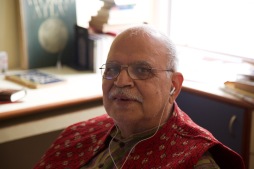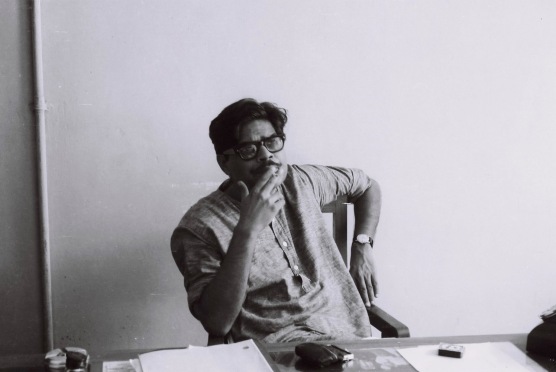Tags
Ankur, Aparajito, Apur Sansar, Aranyer Din Ratri, Ashani Sanket, Bala, Bergman, Charulata, Dilip Padgaonkar, Girish Sahasrabudhe, Jalsaghar, Jana Aranya, Kanchanjungha, Kurosawa, Mahanagar, Mizoguchi, Pasolini, Pather Panchali, Pikoo's Day, Rabindranath Tagore, Rosellini, Satish Bahadur, Seemabaddha, Shatranj Ke Khiladi, Shyam Benegal, The Inner Eye, The Pather Panchali of Satyajit Ray
Satish Bahadur, the guru / Photo SC
Had things gone right, Professor Satish Bahadur should have been the one writing these books, not me. He would have done an infinitely better job than I am ever going to be capable of. So please be warned, dear reader, that in reading my stuff you are compelled to make do with only the second best. Bahadur sahib wrote miles and miles on the black board but was most reluctant to touch pen to paper. Even now I can see the great teacher smiling his blessings through clouds of chalk dust as I begin.
Satish Bahadur was our truly ‘listening’ Professor of Film Appreciation at the Film Institute of India in Pune where I spent three years as student of film direction in the late 60s. Within weeks of our arrival he showed us Pather Panchali, followed by Aparajito and later Apur Sansar. These were eye openers as you can imagine, after which we were converts for life. I certainly was. In 1974 I returned to join the direction faculty but spent that time being an extended student with Prof Bahadur. (Even our offices were next to each other and I would usually be found in his.) When in 1983 he superannuated and left the Institute, I felt very very nervous and alone. He had inspired a whole generation of us but left nothing behind for those coming later. Prof Bahadur passed away in 2010 at 85. He knew at the time that my book on Pather Panchali was on the way but couldn’t hold out. A huge loss personally for me, for I would trust none other’s feedback than his.
><
At the moment I have three books on Apu trilogy to float on this blog. They’ll be released one by one, and true to the spirit of bogging, chapter wise. That should take about a year. That done, more will follow.
The first, therefore, would be a refined version of the The Pather Panchali of Satyajit Ray published by McFarland and Company in the US.

McFarland had plans to bring out an Indian edition through their Indian partners, redesigned but more importantly re-priced for our chiefly browsers’ market. (The American edition was sold exclusively online—you never got to thumb through the book at a book shop—and priced at $55!). But two years on nothing came of it. In February 2014 the rights reverted back to me. Since then my experience with Indian publishers has been dismal. I didn’t know any top honchos and approaching through routine channels they made me feel as though I was looking for a job. Unlike Americans, they were excessively secretive and kept neither their word, nor deadlines. So I have now dropped the idea of getting rich through writing and decided instead to directly reach out to the world sitting at home.


No more squeaky accented women to deal with on the phone, no Bengali commissioning editors assuming exclusive rights on ‘Shautojeet Roy’ to meet in their featureless, sterile cubicles.
The second and third books would be on Aparajito and Apur Sansar. Words for both these are ready, only illustrations remain to be done. I don’t want to ask Girish Sahasrabudhe, who did such an excellent job for Pather Panchali, to do these since I couldn’t pay him matching price for his talent and labour. I paid him just 22 thousand rupees in 2009 whereas 50 should have been in order; today, even more. For my part, in case you are curious and interested, I received just one single cheque of $200 from McFarland for my entire effort on the project! Dileep Padgaonkar told me he received a similar amount from his book on Rossellini or Pasolini, I forget which since I haven’t seen the book. Writers apparently are supposed to make their kill from publicity fallouts of writing: be nominated on committees, invited for lectures, inaugurations, weddings, funerals; essentially from living on page 3. Back in the 70s, the FFC filmmakers earned their monies from non-descript ad shorts, documentaries and corporate films while their New Wave titles got them name and prestige, and from that a claim on large budgets. Post Ankur, Shyam Benegal demanded the use of a state helicopter from Bansi Lal for a Haryana government documentary and got it. The film he made? Never mind.
After Apu trilogy other books under Professor Satyajit Ray can be analyses of famous—or my favourite—scenes from some of his other films, both fiction as well as fact. Or just structural notes on some others without necessarily going into details. Or even related material, say a rare interview with the master, which provides hands on academic insights into Ray’s world suitable for a learning filmmaker. Jalsaghar, Mahanagar, Charulata, Aranyer Din Ratri, Seemabaddha, Jana Aranaya, Kanchenjunga, Ashani Sanket, Shatranj Ke Khiladi, Pikoo’s Day, Rabindranath Tagore, The Inner Eye, Bala. Again words for most of these are ready, sketches would follow. Given the advantages of the medium of blogging I would have colour film illustrations in colour. Publishers tend to cringe having to include colour plates in paper books.
So unless help comes along in some form, I intend to do the rest of the illustrations myself. They are after all no more than black board work, the illustrations, at which I can assure you I wasn’t bad in my days. And who knows, with practice I may even improve!
><
Ray is among the most consistent of filmmakers in the world. Kurosawa, Bergman, Mizoguchi are others on whom my kind of books are possible to write and they could all be learnt from by self-taught filmmakers. In addition, Ray is also rock bottom low on budget, which gives students a sense of kinship with him. In my opinion what learner filmmakers need are insights into the technique of the masters (technique as distinct from technology) and not necessarily their so-called worldview. Nuts and bolts, in other words, of how a scene was put together and not aesthetic discourses as so often tirelessly pedalled and obfuscated by critics and film studies departments. But more of this in my Preface to the Pather Panchali book.
About the same time that I got introduced to Satyajit Ray’s cinema in late 60s, an army cadet explained to me the technique of ballroom dancing that they were offered as hobby in the National Defence Academy. How does the couple relate without stepping on each other’s toes, I wanted to know. Putting his arm around my waist and holding my other hand above, he raised his first elbow in level with the shoulder to offer my free hand a firm support to rest over. The man initiates the woman, he told me, providing her an assurance and trust of security so that she can experience the bliss of romance. A trust that she’d never be cheated by this partner.

I don’t know if the cadet was right on facts about ballroom dancing but watching a Ray film, I certainly feel like that privileged woman.


Sir, am enjoying your blog!
LikeLike
Thanks Charu! It means a lot to me since you are the first to say so! Thanks again.
LikeLike
Anytime sir. My pleasure!
LikeLiked by 1 person
Thanks for your blog sir! Goes to show you are ready to reinvent yourself. It felt like as if you were speaking to me in class. Look forward to the next one.
LikeLike
A good start of nice writing, bro. I’m looking forward to more of them.
LikeLike
You’ll get them Davinder! For sure you’ll!!
LikeLike
मैंने किताब इंटरनेशनल बुक स्टोर , डेक्कन जिमखाना में देखी थी। दिक्षित जी ने कहा बिक्री के लिए नहीं है। कैसे पढूं ?
LikeLike
Upendra Dixit has a copy Manmohan. True, it’s not for sale. It has to come back to me. If you are in Pune, I’ll call him to lend it to you. Let me know.
LikeLike
Sir,…You have a way with words..wonderful language, smooth reading..awaiting more insights from you… Leenus
LikeLike
Thank you Leenus. You’ll have them, the insights!
LikeLike
Realistic and passionate write ups!! Looking forward to read your books! Regards!
LikeLike
Thanks.
LikeLike
Encountering this blog is redolent of a broken romance resumed fortuitously!
LikeLike
Poetic as always Sudhir? Welcome!
LikeLike
Beautiful writing sir.
I am looking forward to reading more of it. As an amature movie enthusiast, getting to read this is like finding a treasure trove.
I have been a die hard fan of Satyajit Ray’s stories and illustrations since childhood and have grown up to be a great admirer of his movies, music and persona. And of course, as a lover of good cinema, I have often lamented about the state of affairs of the Indian film industry and pondered about the absolutely inexplicable complexities of the predominant Indian sensibilities and taste in films.
So for me, it has been a rare stroke of luck that I have come to personally know someone like you who has not just witnessed from a ringside seat, a major part of the evolution of Indian cinema, but also who has had a significant role to play in this saga. And it happens to be a person blessed with your kind of sensibilities, acute observation, astute analytical powers and writing skills!
Thanks once again for putting this out for everyone to read.
LikeLike
I feel overwhelmed Prithvi. It’s for the like of you that I write. Thank you very very much.
LikeLike